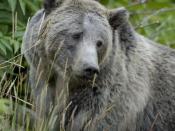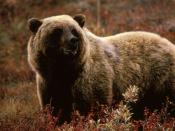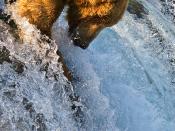Grizzly bears (Ursus arctos horribilis) are important figures in America's wildlife heritage. For many people, the grizzly embodies the spirit of the American Wilderness. Some people even dance in bear masks to keep the grizzly's spirit alive. George Taylor, the owner of Le-La-La Dancers, a Native American troupe states, "When I put on the mask, I become the bear. Grizzly bears represent the strength and power of the woods. I want future generations to see them" (National Geographic 4). Up until the turn of the 20th century, they were fairly common throughout most of the northwest region of the United States. In our world today, many grizzly bears are losing their fight against human intervention in their once well-balanced ecosystem. Most do not realize that annually thousands of species of our flora and fauna are now becoming extinct. This ongoing trend is increasingly threatening our bio diversity and global ecology.
To give a specific example of animal depletion, I will focus on Canadian and western North American grizzlies.
The following factors are responsible for their decline: Hunting, loss of habitat or backcountry development, and just plain apathy on part of the public to preserve the bio diversity of our land. The United States government classifies the grizzly as a threatened species in every state except Alaska (The World Book Encyclopedia 421). Threatened species are those that are likely to become endangered-at least locally-within the foreseeable future. Brown (or grizzly) bears are considered to be locally threatened even though they remain abundant in other parts of their former range (Environmental Science 289). There are only about 58,000 grizzlies left; more than half subsist in Alaska. The limited space has confined grizzlies to Canada, Alaska, and isolated pockets in the U.S. Northwest such as Washington, Montana, Idaho, and Wyoming.
Where should boundaries be drawn for the protection of grizzly bears? It is nearly impossible to have one right answer. There are numerous opinions received on this topic of question. Topics are brought up about predators, property rights, public lands, resource development, environmental laws, guns, and man's rightful place on the planet (National Geographic 13). While all these indifferences are being discussed, grizzly bears are losing their chances of survival. There have been several attempts to reintroduce grizzlies in certain wilderness areas.
On November 16, 2000 the U.S. and Wildlife Services had a news release stating the final steps to reintroducing grizzlies into a 25,000-square-mile Bitterfoot ecosystem in the states of Montana and Idaho. Employees had high hopes from the locals, one states, "This is the first time a reintroduction effort will be overseen by a citizen's group. The Service believes the involvement of local residents is crucial to a successful reintroduction effort"(Morgenweck). I have come to learn these final steps were only the beginning attempts to save the bears. Ultimately the U.S. and Wildlife Service efforts were declined due to so many complaints of people living near those areas.


